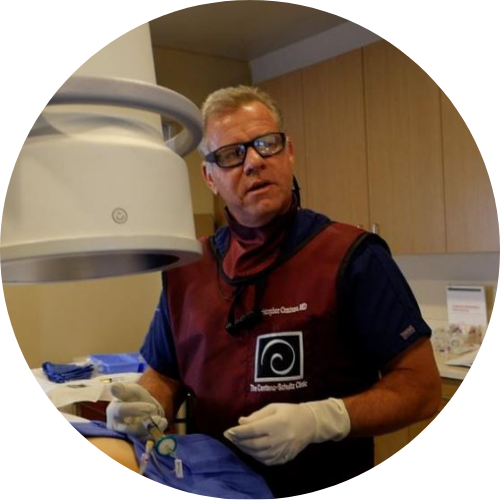Facet Joint Injections
Am I a Candidate?In the realm of healthcare, pain management plays a pivotal role. Among the myriad of treatments available, one that stands out for its effectiveness and simplicity is the facet joint injection.
This procedure has been instrumental in diagnosing and alleviating pain associated with facet joints – small but crucial parts of the spine.
What Is a Facet Joint?
A facet joint, also known as a zygapophysial, is a small joint in the spine. It is a paired joint that occurs at each level of the spine. Accordingly, there is a right and left facet joint at each level of the cervical, thoracic, and lumbar spine.1
The facet joint is located at the backside of the spine. It is on either side of the spinous process (the ‘dinosaur bone’) and can be felt on slender patients. The facet joint is formed by two bones coming together: the superior articular and inferior articular process. This is similar to the knee joint created by the union of the thigh bone (femur) and shin bone (tibia).
A facet joint is a synovial joint with the following characteristics:
- Synovial cavity: space created by the two bones
- Synovial fluid: clear fluid that lubricates the joint
- Articular cartilage: strong, flexible, connective tissue that covers the ends of the bones and allows smooth, gliding motion of the joint
- Joint capsule: a fibrous structure that envelopes the joint. A saran wrap covers the joint and keeps the synovial fluid within the joint.
- Ligaments: thick bands of connective tissue that surround the joint and provide critical stability and support
The facet joint provides stability to the spine, limits excessive motion, and absorbs some of the forces placed on the spine.2
What Is the Function of a Facet Joint?
The facet joints in the cervical, thoracic, and lumbar spine are important shock absorbers in the posterior portion of the spine. They also limit rotation backward bending (extension) and stabilize the spine when bending.3 This is a gigantic task for a small joint, and because of it, the joint is susceptible to excessive wear, degeneration, and injury.
Trauma such as a rear-end motor vehicle accident can injure the facet joint. Facet injury can lead to arthritis and pain in the joint. Lumbar facets are a common source of pain, accounting for 15-45% of low back pain.4 Facet joint pain in the lumbar spine is commonly localized in the lower back and may involve the buttocks and the posterior thighs.
What Are Facet Joint Injections?
Facet injections are medical procedures for injecting medication directly into or adjacent to a targeted facet joint. The principal goal is to reduce pain and inflammation. Another goal can be diagnostic, asking whether or not a targeted facet joint is the principal source of pain. There are three principal types of facet injections, which are discussed below.
Intraarticular Facet Joint Steroid Injections
An intra-articular joint injection is a medical procedure utilized in pain management where a needle is advanced directly into the targeted facet joint. The needle is advanced under X-ray and/or ultrasound guidance. After appropriate needle placement, contrast (dye) is injected to confirm the accurate placement of the needle and the intended medication.
After that, a local anesthetic and a high-dose steroid are injected. The latter should be avoided as it can damage the articular cartilage, capsule, and supporting ligaments in the facet joint.
Medial Branch Blocks
The medial branch nerve (also known as the medial branch of the dorsal primary ramus) is the nerve in the spine that provides sensation (feeling) to a specific facet joint. A medial branch block is a medical procedure where local anesthetic and steroids are injected immediately adjacent to the medial branch nerve. The goal is to diagnose and treat pain originating from the facet joint.
In conventional pain management procedures, a medial branch block is typically administered after a patient experiences substantial pain reduction, albeit with limited duration, from an intra-articular joint injection. When a patient demonstrates significant pain reduction following an intra-articular facet and medial branch block, it confirms the diagnosis of facet-mediated pain.
Radiofrequency Ablation (RFA)
Radiofrequency ablation is an advanced procedure for pain management whereby thermal energy is utilized to treat pain originating from facet joints. It is alternatively referred to as RFA, radiofrequency neurotomy, radiofrequency lesioning, or radiofrequency thermal ablation.
The procedure involves the use of a specialized spinal needle that is guided by an X-ray to reach the path of the medial branch nerve. Once accurate needle placement is confirmed, thermal energy is applied to heat the needle tip to 90o Celsius (194o Fahrenheit). It is worth noting that water boils at 100oC (212oF).
This controlled heating process cauterizes the medial branch nerve and the adjacent tissue, effectively blocking the conduction of pain signals from damaged or injured facet joints to the brain.
The procedure can elicit discomfort and typically necessitates oral narcotics and possibly muscle relaxants for 7-10 days. Patients commonly report pain reduction for six to nine months, after which the procedure may need to be repeated due to the regeneration of the medial branch nerve.
Importantly, radiofrequency ablation does not address the damaged or injured facet joint; rather, it is a therapeutic procedure that disrupts the transmission of pain signals from the joint to the brain by employing nerve-burning techniques. Untreated, underlying injury or damage to the facet joint processes can persist in many cases.
Cervical, Thoracic, and Lumbar Facet Joint Injections
Facet joint injections can be performed in the cervical (neck), thoracic (mid-back), and lumbar (lower back) regions of the spine. The procedure is similar for all three regions, with the main difference being the location of needle placement under imaging guidance. These injections are commonly used to treat pain from degenerative changes or injuries in these areas of the spine.
Facet joint injections typically serve two primary objectives: to aid in the diagnosis of the location and cause of pain and to offer pain relief. By administering anesthetic medication directly into the joint, the extent of immediate pain relief experienced can help confirm or rule out the joint as the source of pain.
If complete relief from the main pain is achieved while the facet joints are numb, these joints are probably the underlying cause of the pain.
Are Facet Joint Injections Painful?
Pain varies from patient to patient. Facet injections should be performed under intermittent X-ray guidance, where contrast can confirm the appropriate needle placement. The injection can be performed with or without IV sedation, depending upon the preference of the patient and provider, the level to be injected, and the severity of the facet damage.
When performed without sedation, the skin and subcutaneous layers are injected with numbing medication. Other factors that may influence the level of pain during a facet joint injection include the size of the needle, the amount of tissue between the skin and the target site, and the joint physician’s experience, as well as the severity of spinal pain before the injection.
Both intra-articular facet joint and medial branch blocks can be performed with or without IV sedation. Radiofrequency ablation is best performed with sedation due to the large needles used, heating of the needle tip, and burning of the tissue.
Are Facet Joint Injections Dangerous?
Facet injections are one of the treatment options for neck, thoracic, and lower back pain that has not responded to conservative care.5 Injections directly into the joint (intra-articular) and medial branch blocks are the most common injections performed.6
All injections have inherent risks and possible complications. These include bleeding, infection, failure, escalation in pain, nerve damage, and reduction in heart rate.7 Medications injected include local anesthetic and steroids.
Steroids are hazardous as they are toxic to joint cartilage8 and your body’s stem cells,9 and negatively impact your stress management hormones.10
Thoracic facet, medial branch block, and RFA have unique risks, given their proximity to the lungs and other vital organs. Thoracic injections risk puncturing the lungs or other vital structures, possibly resulting in life-threatening conditions.
Radiofrequency ablation has been associated with atrophy of the multifidus muscle, which can compromise spinal stability.11
PRP Injections for Facet Joints: a Regenerative Treatment Option
PRP (platelet-rich plasma) is an effective alternative to steroids in treating facet pain.12 PRP is rich in growth factors that can reduce inflammation and promote healing without the toxic side effects of steroids. Blood is typically obtained from the arm, processed to concentrate the growth factors, and reinjected into the facet joint.
Unlike intra-articular facet, medial branch block, and radiofrequency ablation, PRP can address the underlying facet injury and improve mild to moderate joint osteoarthritis and capsular instability.
Clinical Approach for Best Outcomes
For patients to get the best clinical results, a different approach to pain management is required. In most pain practices, the focus is identifying the “principal pain generator” – the structure responsible for a given patient’s pain. Focus and treatment are then directed at the principal pain generator.
At the Centeno-Schultz Clinic, we acknowledge that each of the 24 levels in the cervical, thoracic, and lumbar spine are more than just single parts. Rather, the 24 spinal levels work in concert with the multiple muscles, tendons, ligaments, and nerves in a highly synchronized fashion. All the parts work together.
This concept is called the functional spinal unit (FSU), composed of multiple parts, including the disc, facet joints, ligaments, bones, and muscles. Each of these is critical in providing stability to the spine. To learn more about the different parts and their role, please click on the video below.
At the Centeno-Schultz Clinic, we evaluate and treat all the affected tissues with a regenerative approach. High-dose steroid intra-articular facet injections are not offered, as they fail to treat the underlying facet injury and can be toxic to the articular cartilage that lines the facet joint.
Neither is radiofrequency ablation offered, as it is a destructive procedure with atrophy of the multifidus muscle that provides important spinal stability.
Get the Best Outcome for Your Facet Joint
Facet joints are small, paired joints at each spine level: cervical, thoracic, and lumbar. The joint is lined with cartilage, surrounded by fibrous capsules, and restricts excessive motion in the spine. It also provides important stability for the spine.
Facet joints are susceptible to degeneration and injury and can become a source of significant spinal pain.
A facet joint injection is a medical procedure utilized in pain management to diagnose and treat pain arising from a facet joint. In traditional pain practices, there are three principal types of facet injections: intra-articular, medial branch block, and radiofrequency ablation.
All injections must be performed with X-ray or ultrasound guidance to ensure accurate needle placement. Risk factors include bleeding, infection, escalation in pain, and nerve damage. In the thoracic spine, facet injection risks include puncture and collapse of the lung or other vital structures.
High-dose steroids and thermal destruction of the median nerve do not address or treat the underlying joint injury or instability. PRP and bone marrow concentrate are rich in growth factor and progenitor cells, which can address and accelerate the healing of these injuries.
Clinical outcomes improve when the spine is viewed and treated as a functional unit. Learn more about this and other back surgery alternatives.

Christopher J. Centeno, MD
Christopher J. Centeno, M.D. is an international expert and specialist in Interventional Orthopedics and the clinical use of bone marrow concentrate in orthopedics.
Dr. Centeno is one of the few physicians in the world with extensive experience in the culture expansion of and clinical use of adult bone marrow concentrate to treat orthopedic injuries. His clinic incorporates a variety of revolutionary pain management techniques to bring its broad patient base relief and results. Dr. Centeno treats patients from all over the US who travel to Colorado to undergo innovative, non-surgical treatments. Dr. Centeno has chaired multiple international research-based conferences. He also maintains an active research-based practice, with multiple publications listed in the US National Library of Medicine. Dr. Centeno has also served as editor-in-chief of a medical research journal dedicated to traumatic injury.
Dr. Centeno trained at the Baylor College of Medicine, Texas Medical Center, and the Institute for Rehabilitation Research. He hails from both Florida and New York and currently resides in Boulder, Colorado with his wife and three children.

John Schultz, MD
John R. Schultz M.D. is a national expert and specialist in Interventional Orthopedics and the clinical use of bone marrow concentrate for orthopedic injuries. He is board certified in Anesthesiology and Pain Medicine and underwent fellowship training in both. Dr. Schultz has extensive experience with same day as well as culture expanded bone marrow concentrate and sees patients at the CSC Broomfield, Colorado Clinic, as well the Regenexx Clinic in Grand Cayman. Dr. Schultz emphasis is on the evaluation and treatment of thoracic and cervical disc, facet, nerve, and ligament injuries including the non-surgical treatment of Craniocervical instability (CCI). Dr. Schultz trained at George Washington School of…
Read more
John Pitts, M.D.
Dr. Pitts is originally from Chicago, IL but is a medical graduate of Vanderbilt School of Medicine in Nashville, TN. After Vanderbilt, he completed a residency in Physical Medicine and Rehabilitation (PM&R) at Emory University in Atlanta, GA. The focus of PM&R is the restoration of function and quality of life. In residency, he gained much experience in musculoskeletal medicine, rehabilitation, spine, and sports medicine along with some regenerative medicine. He also gained significant experience in fluoroscopically guided spinal procedures and peripheral injections. However, Dr. Pitts wanted to broaden his skills and treatment options beyond the current typical standards of care.
Read more
Jason Markle, D.O.
Post-residency, Dr. Markle was selected to the Interventional Orthopedic Fellowship program at the Centeno-Schultz Clinic. During his fellowship, he gained significant experience in the new field of Interventional Orthopedics and regenerative medicine, honing his skills in advanced injection techniques into the spine and joints treating patients with autologous, bone marrow concentrate and platelet solutions. Dr. Markle then accepted a full-time attending physician position at the Centeno-Schultz Clinic, where he both treats patients and trains Interventional Orthopedics fellows. Dr. Markle is an active member of the Interventional Orthopedic Foundation and serves as a course instructor, where he trains physicians from around the world.
Read more
Brandon T. Money, D.O., M.S.
Dr. Money is an Indiana native who now proudly calls Colorado home. He attended medical school at Kansas City University and then returned to Indiana to complete a Physical Medicine and Rehabilitation residency program at Indiana University, where he was trained on non-surgical methods to improve health and function as well as rehabilitative care following trauma, stroke, spinal cord injury, brain injury, etc. Dr. Money has been following the ideology behind Centeno-Schultz Clinic and Regenexx since he was in medical school, as he believed there had to be a better way to care for patients than the status quo. The human body has incredible healing capabilities…
Read moreReferences:
- Yahia LH, Garzon S. Structure on the capsular ligaments of the facet joints. Ann Anat. 1993;175(2):185–188.DOI: 10.1016/s0940-9602(11)80179-2
- Jaumard NV, Welch WC, Winkelstein BA. Spinal facet joint biomechanics and mechanotransduction in normal, injury and degenerative conditions. J Biomech Eng. 2011 Jul;133(7):071010. doi: 10.1115/1.4004493. PMID: 21823749; PMCID: PMC3705911.
- The mechanical function of the lumbar apophyseal joints. Adams MA, Hutton WC. Spine (Phila Pa 1976). 1983 Apr; 8(3):327-30.DOI: 10.1097/00007632-198304000-00017
- Perolat R, Kastler A, Nicot B, et al. Facet joint syndrome: from diagnosis to interventional management. Insights Imaging. 2018;9(5):773-89. doi: 10.1007/s13244-018-0638-x.
- Filippiadis DK, Kelekis A. A review of percutaneous techniques for low back pain and neuralgia: current trends in epidural infiltrations, intervertebral disk and facet joint therapies. Br J Radiol. 2016;89(1057):20150357. DOI: 10.1259/bjr.20150357.
- Dreyfuss PH, Dreyer SJ, Herring SA. Lumbar zygapophysial (facet) joint injections. Spine. 1995;20(18):2040-7.DOI: 10.1097/00007632-199509150-00019.
- Velickovic M, Ballhause TM. Delayed onset of a spinal epidural hematoma after facet joint injection. SAGE Open Med Case Rep. 2016;4:2050313X16675258. DOI: 10.1177/2050313X16675258.
- Wernecke C, Braun HJ, Dragoo JL. The Effect of Intra-articular Corticosteroids on Articular Cartilage: A Systematic Review. Orthop J Sports Med. 2015;3(5):2325967115581163.doi: 10.1177/2325967115581163.
- Shao J, Xu X, Li G, et al. Inhibitory effects of pharmacological doses of dexamethasone on mineralization of mesenchymal progenitor cells in vitro. Pharmazie. 2009;64(10):674-9.
- Chon JY, Moon HS. Salivary cortisol concentration changes after epidural steroid injection. Pain Physician. 2012;15(6):461-6.
- Dreyfuss P, Stout A, Aprill C, Pollei S, Johnson B, Bogduk N. The significance of multifidus atrophy after successful radiofrequency neurotomy for low back pain. PM R. 2009 Aug;1(8):719-22. doi: 10.1016/j.pmrj.2009.05.014. PMID: 19695523.
- Wu J, Du Z, Lv Y, et al. A New Technique for the Treatment of Lumbar Facet Joint Syndrome Using Intra-articular Injection with Autologous Platelet Rich Plasma. Pain Physician. 2016;19(8):617-25.
Am I a Candidate?
To answer this question, fill out the candidate form below to request a new patient evaluation, and a patient advocate will reach out to you to determine your next steps. Your one-hour, in-office or telemedicine evaluation will be with one of the world’s experts in the field of Interventional Orthopedics.